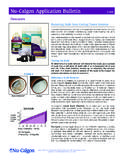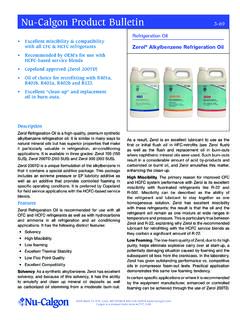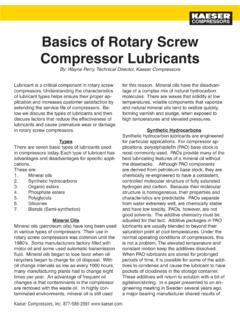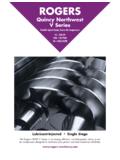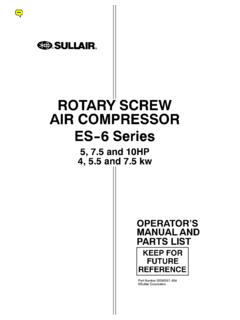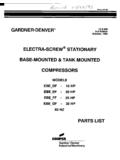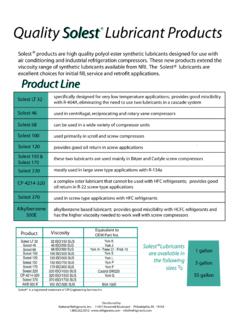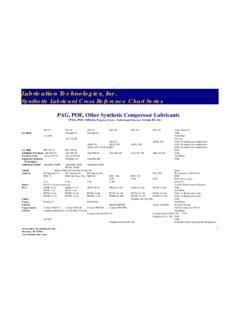Transcription of Nu-Calgon Product Bulletin
1 Nu-Calgon Product Bulletin 3-68. The industry's choice of a fully formulated Refrigeration Oils polyol ester lubricant Emkarate RL lubricants Most OEM approved, recognizable POE. lubricant in the market Some approvals: RL32-3 MAF/RL68HB for Copeland, Caryle's RL68H, and RL85HB. for Bitzer For HCFC, HFC, HFO, hydrocarbon and CO2. refrigerants Compatible with mineral oils, alkylbenzenes, PVE and PAG lubricants RL68HB and RL85HB for subcritical and transcritical CO2 applications Full line-up types and package sizes for market needs Description Critical issues The Emkarate family of lubricants is a wide range of Additives vs Non-Additives. The preference is to specify polyol ester refrigeration oil products.
2 They are designed lubricants that do not contain additives, as they are not specifically for use with HFC refrigerants, now HFC/HFO needed in the majority of cases using properly formulated blends, HFO, hydrocarbon and CO2 refrigerants developed base lubricants . Experiences such as decreased lubricant to meet the performance demands of the refrigeration stability, sludge formation, and component deposits, are industry. This superior performance is achieved with concerns related to the use of additives. At the same time, it basefluids that are specifically formulated to deliver is understood that additives can also enhance performance optimum performance with minimal additive levels.
3 In certain particularly demanding applications may be necessary, such as CO2 systems. Application Miscibility. Since some lubricant will travel with the The requirements of today's refrigeration and air refrigerant in any air conditioning or refrigeration system, conditioning compressor lubricants are complex. They it is imperative that they be fully miscible and soluble must be compatible and miscible with the HFC refrigerants with one another at all temperatures that the system will and newer refrigerant options, and they must be compatible experience. This ensures good oil return and lubricity to and miscible with the older refrigerants, such as HCFCs, as the compressor , and no blockage or loss of heat transfer in well as mineral and alkylbenzene oils.
4 Polyol ester lubricants the evaporator. In traditional systems, the HCFC refrigerant meet these needs, and the EMKARATE RL line is the is miscible and soluble with the mineral or alkylbenzene preferred industry choice. Working in close collaboration oil. On the other hand, if these oils and an HFC refrigerant with compressor and system manufacturers, these OEM- are mixed, they are mutually immiscible and essentially approved POE lubricants cover a wide viscosity range insoluble. They will separate into two distinct phases in from 7 cSt (35-40 SUS) to 220 cSt (1100 SUS) to suit most the evaporator and the oil will coat the inside of the tubes, applications. The lubricants have excellent thermal and resulting in a loss of heat transfer and potentially a lack of chemical stability, and are compatible with a wide range lubrication in the compressor .
5 Of elastomers, polymeric materials and other materials of construction. Additionally, then higher viscosity index is HFC refrigerants and POE lubricants are fully miscible and an indication that their effective viscosity will not change have high mutual solubility. As a result, POE lubricants are drastically with the wide swings in temperature seen by the proper choice when using today's HFC refrigerants and most typical refrigeration and air conditioning systems. the lubricant often selected with the newer choices in the They are the preferred choice for servicing and retrofitting market. existing equipment as well as for OEM charging. 2008 Altom Ct. St. Louis, MO 63146 800-554-5499 Calgon is a licensed trade name (1117) 3-68.
6 Blending Different POE Brands Moisture compressor manufacturers often approve several Hygroscopicity is the term used to describe a lubricant's lubricants for use in a particular compressor application. affinity for moisture, and POEs are known to be Part of the process of approving them is the understanding hygroscopic. They absorb water more quickly than mineral that the approved oils may end up being blended with or alkylbenzene oils from the surrounding environment. For each other in a system. The blending of approved oils is this reason, care should be exercised during the servicing most acceptable. When in doubt, consult the compressor of equipment charged with or about to be charged with a manufacturer.
7 Polyol ester. There are two main types of POE oils currently approved for At the same time, if acceptable packaging and good use in refrigeration compressor applications: unaddivated service procedures are used and care is exercised in the POEs and formulated POEs which may contain up to 3% handling of the oil, moisture should not be a problem. If additives. the container of the POE is metal and it is tightly sealed When two unaddivated lubricants are mixed, the after each use, no serious ingress of moisture should performance of the resulting blend is between the occur to unused oil. In addition, the use of the appropriate performance of the separate lubricants . So long as the filter-driers and proper service practices will result in the lubricants are approved, the resulting mixture should effective control and removal of moisture.
8 In fact, since be suitable. However, when a non-additized lubricant is HFCs effectively compete with the POE for any moisture blended with an additized lubricant, some decrease in the present ( water moves from the oil to the refrigerant), the performance of the additive may be seen since the additive moisture will be more easily removed from the refrigerant dose rate of the formulated lubricant will be diluted by the by the filter-driers in the refrigerant-rich environment in the unaddivated lubricant. This can be especially problematic liquid and/or suction line. for formulated oils containing foaming agents as these agents tend to be very dose-rate sensitive. Care should be taken and the OEM consulted for advice.
9 TYPICAL PROPERTIES. PROPERTY AND RL RL RL RL RL RL RL RL RL RL RL RL RL RL. PROCEDURE 22H 32-3 MAF 32H* 32HB 46H 68H 68HB 68HP* 85HB 100H 100E 170H 220H+ 220XL. Viscosity @ 40 C. 100 170 220 220. (cSt), ASTM D-445. Viscosity @ 100 C. (cSt), ASTM D-445. Typical SUS Viscosity 100 150 150 150 200 300 300 300 425 500 500 850 1100 1100. @ 100 F. Viscosity Index, 124 125 121 121 118 122 122 114 110 103 120 107 97 97. ASTM D-2270. Pour Point ( C), -57 -40 -55 -46 -48 -39 -39 -39 -39 -31 -20 -25 -30 -30. ASTM D-97. Density @ 20 C (g/. ml), ASTM D-1298. Flash Point (COC) ( C), 260 240 264 264 260 270 270 270 273 265 230 290 300 300. ASTM D-92. Acid Value (mgKOH/g), < < < < < ASTM D-974 modified Water Content (ppm), <50 <50 <50 <50 <50 <50 <50 <50 <50 <50 <50 <50 <50 <50.
10 ASTM E 1064-85. Refractive Index 28 C. Viscosity Designations: 3 MAF = Copeland Formulation; H = High Solubility; N = HP & HC = Special for Carrier Internally Geared Chillers Approval Chart for Emkarate POE lubricants Company compressor Type POE Lubricant Type Bitzer Reciprocating (M) RL32H. Reciprocating (H) RL68H. Reciprocating (CO2) RL85HB. Screw RL170H. Blissfield Reciprocating (M) RL32H. Reciprocating RL68H. Bock Reciprocating RL22H, RL32H. Reciprocating RL46H, RL68H, RL100H. Boeing Service (Aerospace) RL68H. Carlyle, Reciprocating (Marine Containers) RL22H. Carrier, Centrifugal (17DA & 17EA) RL32H. Transicold Centrifugal (17 MPS & 17FA) RL68H. Centrifugal (17EX, 19EA, EB, FA, 19XL/XT, 19EX, 19XR/XRT) RL68HP.


